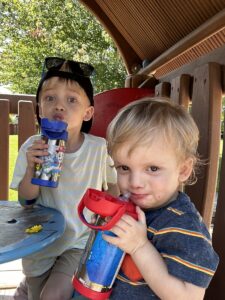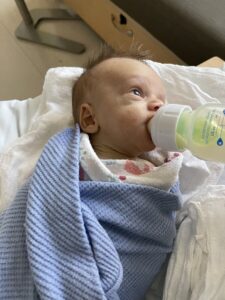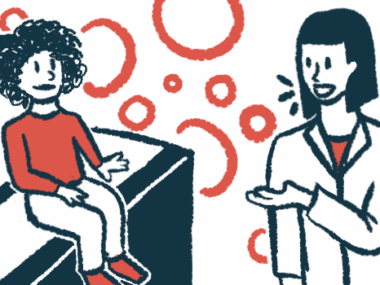Struggling with anxiety about a change in routine for my son
Shifting his formula habits prompts concern about his nutrition
Written by |

Routines are foundational aspects of life with kids. Having a healthy, normal schedule helps the day flow. Kids will always throw a curveball or two, but it’s easier to get back on the rails when there’s a routine in place.
Right now, at my house, we’re working through a massive transition with my son Finley. This change in routine brings medical anxiety for me and stress for Finley.
Finley was born with Alagille syndrome. As a result, his liver has difficulty processing fats, leading to challenges with growth and weight gain. A major focus of his treatment is nutrition. Since birth, formula has been a staple in his diet. He had special infant formula for malabsorption issues, and once he outgrew that, he started taking a formula for toddlers.
He always drank both without issue, so while we occasionally worried about our shipment arriving on time, we never had to worry about him getting enough calories.
The recent change has to do with how Finley takes his formula. He’s been right on track developmentally when it comes to drinking from a cup, straw, or water bottle — but only with drinks besides his formula. We’ve been trying to get Finley to drink formula from a cup for what feels like years, which is crazy considering he’s only 3.5 years old.
My wife and I would present the formula in the same cups Finley drank water from, but to no avail. It was frustrating as we knew he could do it. But for us, the medical anxiety related to his Alagille syndrome diagnosis would take over.
While Finley is a good eater, his nutrition has been at the forefront of our minds since the term “failure to thrive” was used to describe him as a baby. He needs the extra calories, and we need the peace of mind knowing that he’s getting them. So even if he was “aging out” of using the baby bottle, switching methods didn’t seem worth the battle, as long as he was drinking his formula.
Still, we knew we’d have to make the change at some point, and doing so would only get harder by the day.
Making the switch
About a week ago, we decided it was time to retire the bottles. The “babas,” as Finley still calls them, had been a constant in his life since birth. His morning routine included one, and he always had quiet baba time on the couch before bed. At day care, he’d drink from his baba before his midday nap. So he wasn’t happy when he realized we’d bought some new cups for him to try.
As his caregivers, my wife and I had to put aside our deep medical anxiety to make this change in routine. Finley will be 4 before we know it. Although he didn’t feel ready, it was time.
It was not an easy transition. Finley’s familiar routines were flipped upside down. There was screaming and anger when we told him, “No more baba; you can use a cup.” Holding firm in that moment was hard. I know he needs the calories, but this change was important to facilitate.
A couple days later, when I was out of town with my older son, Jackson, Finley threw a massive tantrum over not getting his formula in his baba. I sure wish there were a manual for these sorts of transitions.
It’s now been almost two weeks since the change, and while Finley is still asking for his baba, he’s also accepting a regular cup. He’s become fond of the silly straw variety. Despite our anxiety, I know we’ll all get through this change in routine. It may be challenging, but it’ll benefit Finley in the long run.
One thing we’ve noticed is that Finley wants to eat way more food. If he’s not drinking as much formula, it makes sense that he’d be seeking out the extra calories he needs. That’s been wonderful to see and has calmed some of my medical anxiety.
Do we wish we initiated this change in routine sooner? Absolutely. Was there a “correct” time to do so? Honestly, I’m not sure. But I do know that despite the challenges, Finley will excel once he adapts to the change.
Note: Liver Disease News is strictly a news and information website about the disease. It does not provide medical advice, diagnosis, or treatment. This content is not intended to be a substitute for professional medical advice, diagnosis, or treatment. Always seek the advice of your physician or other qualified health provider with any questions you may have regarding a medical condition. Never disregard professional medical advice or delay in seeking it because of something you have read on this website. The opinions expressed in this column are not those of Liver Disease News or its parent company, Bionews, and are intended to spark discussion about issues pertaining to liver disease.










Leave a comment
Fill in the required fields to post. Your email address will not be published.